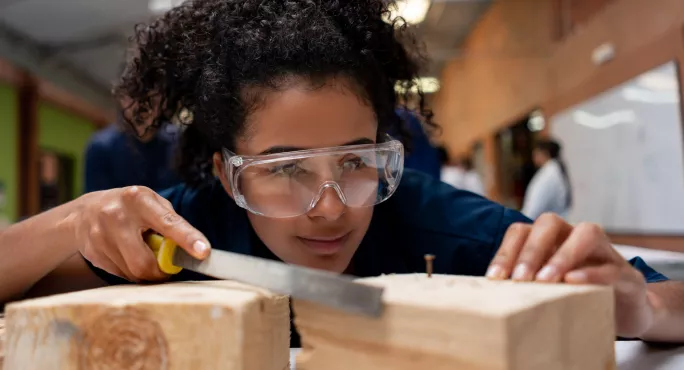- Home
- Teaching & Learning
- Secondary
- We must ditch the dusty view of design and technology
We must ditch the dusty view of design and technology

Scottish comedian Kevin Bridges affectionately describes his experience in “woodwork” class - being asked to manufacture that most stereotypical of class projects: the humble spice rack.
It’s a reference that will no doubt resonate with many Scottish adults and invoke nostalgia of their own technological education. As a design and technology (D&T) teacher, I often encounter parents’ amazement that the “woodwork” department of old now offers instruction not only in the fabrication of little wooden flavour-holders but also in computer-aided design, coding and the use of 3D printers or laser cutters, among other things.
Exactly a year ago, in response to the pandemic and growing concerns over the increasing shortage of personal protective equipment (PPE), “woodwork” teachers all over the country used these skills to help fabricate tens of thousands of face shields. Yet, even as the world around us becomes more technologically advanced every day, the nation’s impression of technological education seems to have stagnated into an image of dusty workshops and, yes, spice racks.
Background: Bursary scheme for Stem student teachers is extended
Student teachers: One in 10 places on secondary teaching courses unfilled
School technology: The teacher 3D printing visors for NHS staff
Covid: How one school transformed pastoral care during the pandemic
Scottish Parliament election 2021: Bring back principal Stem teachers, say Lib Dems
Meanwhile, 5 April brought the relaunch of the £20,000 Stem (science, technology, engineering and maths) bursary for those changing career to become teachers in chemistry, computing science, home economics, maths, physics and technical education. Yet, despite this attractive incentive, only 72 per cent of initial teacher education (ITE) places for technological education were filled this year.
The scarcity of D&T teachers in Scotland
There is, certainly, a scarcity of D&T teachers in Scotland, which is particularly dire in the North East. Advertised vacancies in Aberdeenshire, indeed across the Northern Alliance, are few and far between; not because there are no jobs but because there are no applicants. So why no interest? Surely everyone knows about those 3D printers and laser cutters, right? Right?
Technological education, technical studies, design and technology or just “techie” - whatever we call it - is a fusion of disciplines delivered in Scottish secondary schools that is continually evolving. D&T encapsulates the traditional, vocational skills of practical woodwork and metalwork, but also the academic studies of engineering science, the technical drawing in graphic communication and the creative flair of design and manufacture. D&T’s breadth is its strength, but could that also be a weakness?
There are currently three routes into technology teaching: the MDTechEd (replacing the BTechEd) at the University of Glasgow; the professional graduate diploma in education (PGDE) at the universities of Edinburgh, Stirling, Strathclyde and UHI; and the new BSc Hons in education and curricular studies with teaching qualification at the University of Strathclyde (a new model that allows direct entry into third year to students with an HND in a relevant discipline). The University of Aberdeen, however, doesn’t offer a qualification in technological education in any format.
General Teaching Council for Scotland (GTCS) registration is generally only given to one secondary education category before additional probationary periods are required for dual qualification. However, unlike most of our secondary colleagues, D&T teachers do not qualify in a discrete subject, instead coming under the umbrella term of “technological education”. This can cause issues when schools design their timetable or advertise posts because each D&T department will offer its own host of various subject combinations. This means it is possible for an experienced teacher to start a job at a neighbouring school and have a timetable full of subjects they’ve never taught before.
My own department is staffed mainly by teachers who have waived their preference for a local authority during their probationary year - but this option may not be viable for new teachers with families to support or those who are unable to relocate. With the University of Aberdeen not currently offering any D&T training and UHI allocating its placements firmly within its own authorities, there is little chance of us recruiting a lot of homegrown talent in the North East.
Perhaps it is a crisis of identity - are would-be engineering science teachers being put off by their memories of spice racks and tenon saws? Perhaps removing the umbrella term of technological education” in favour of discrete subjects would boost applicant numbers. Could we even attract tradespersons with teaching posts that would be purely workshop-based? Are we are losing potential Stem teachers to other Stem careers with more attractive working conditions?
Every subject specialist will always passionately argue the importance of their own area of expertise, but I firmly believe that ensuring students have access to a broad D&T education would help to mitigate the Stem skills shortage. Design and technology offers extensive, rich and relevant experiences and skills to students, and perhaps through raising its profile and celebrating its diversity, we will be able to attract more to the profession.
My school’s strapline is “Building skills for today, tomorrow and the future”. I am concerned, however, that unless we can increase D&T teacher recruitment, techie departments may grow dusty through lack of use - just like that old spice rack at the back of your cupboard.
Caroline McFarlane is principal teacher of design and technology at Banff Academy, in Aberdeenshire
You need a Tes subscription to read this article
Subscribe now to read this article and get other subscriber-only content:
- Unlimited access to all Tes magazine content
- Exclusive subscriber-only stories
- Award-winning email newsletters
Already a subscriber? Log in
You need a subscription to read this article
Subscribe now to read this article and get other subscriber-only content, including:
- Unlimited access to all Tes magazine content
- Exclusive subscriber-only stories
- Award-winning email newsletters
topics in this article



